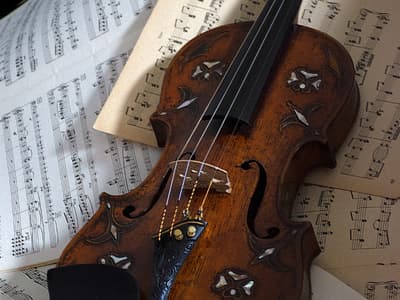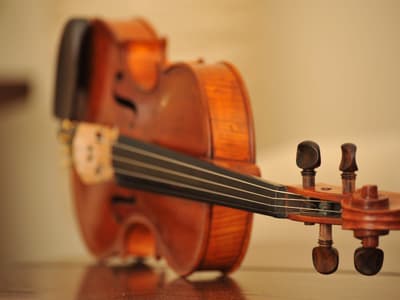In this article, we will introduce you to five exceptional German violin makers with a bright future. Discover who they are and what makes their violins special!
German violin makers
The world of violin making is competitive, with only a select few rising to the top to become true masters of the craft. German violin makers have a long and proud history of producing some of the finest instruments in the world, and today is no exception.
In this article, we will introduce you to five exceptional German violin makers making waves in the industry and are considered by many experts to have a bright future ahead of them.
From traditional techniques to modern innovations, these makers are pushing the boundaries of what is possible in the world of violin making and are creating instruments that are truly works of art.
Whether you’re a professional musician, a collector, or simply a lover of beautiful instruments, you won’t miss this look at some of the most exciting and talented violin makers working in Germany today.
Stefan-Peter Greine
Stefan-Peter Greiner is a German violin maker based in Cremona, Italy. He is known for his exceptional craftsmanship and attention to detail.
He began his apprenticeship as a violin maker in his native Germany and later studied at the International School of Violin Making in Cremona, Italy.
He has won several awards for his work, including the Silver Medal at the Triennale di Cremona and the Gold Medal at the International Competition of Violin Making in Mittenwald, Germany.
The Cremonese tradition of violin making heavily influences Greiner’s work, and he is particularly known for his ability to replicate the sound and style of the classic Cremonese violins.
He uses traditional materials and techniques in his work, such as hand-carving the wood and using natural varnishes. His violins have been praised for their tonal balance, projection, and response. He also makes other string instruments like cellos and violas.
He is considered one of the most promising contemporary violin makers, and his violins are highly sought after by professional musicians, collectors, and enthusiasts worldwide.
Thomas Gerbeth
Thomas Gerbeth is a German violin maker based in Erlangen, Germany. He began his apprenticeship as a violin maker in Germany and later studied at the International School of Violin Making in Cremona, Italy.
He has won several awards for his work, including the Gold Medal at the International Competition of Violin Making in Mittenwald, Germany.Gerbeth is known for his precise craftsmanship and for creating great beauty and elegant violins.
He is particularly interested in the history of violin making and studying the classic Cremonese masters. He uses traditional materials and techniques in his work, such as hand-carving the wood and using natural varnishes. His violins have been praised for their tonal balance, projection, response, and aesthetic appeal.
He also makes other string instruments like cellos and violas and is considered one of the most promising contemporary violin makers; his instruments are highly sought after by professional musicians, collectors, and enthusiasts worldwide.
Christoph Meinel
Christoph Meinel is a German violin maker based in Markneukirchen, Germany. He began his apprenticeship as a violin maker in his native Germany and later studied at the International School of Violin Making in Cremona, Italy.
He has won several awards for his work, including the Silver Medal at the Triennale di Cremona and the Gold Medal at the International Competition of Violin Making in Mittenwald, Germany.
Meinel is known for his innovative violin-making approach, blending traditional techniques with modern technology. He is particularly interested in using new materials and studying the acoustic properties of wood.
His work uses traditional and modern materials, such as hand-carving wood and advanced computer-aided design techniques. His violins have been praised for their tonal balance, projection, response, and aesthetic appeal.
He also makes other string instruments like cellos and violas and is considered one of the most promising contemporary violin makers; his instruments are highly sought after by professional musicians, collectors, and enthusiasts worldwide.
Jörg Rabestein
Jörg Rabestein is a German violin maker based in Berlin, Germany. He began his apprenticeship as a violin maker in his native Germany and later studied at the International School of Violin Making in Cremona, Italy.
He has won several awards for his work, including the Silver Medal at the Triennale di Cremona and the Gold Medal at the International Competition of Violin Making in Mittenwald, Germany.
Rabestein is known for his precise and meticulous craftsmanship and for creating great beauty and elegance violins. He is particularly interested in the history of violin making and studying the classic Cremonese masters. He uses traditional materials and techniques in his work, such as hand-carving the wood and using natural varnishes.
His violins have been praised for their tonal balance, projection, response, and aesthetic appeal.He also makes other string instruments like cellos and violas and is considered one of the most promising contemporary violin makers; his instruments are highly sought after by professional musicians, collectors, and enthusiasts worldwide.
David Bagué
David Bagué is a German violin maker based in Berlin, Germany. He began his apprenticeship as a violin maker in his native Germany and later studied at the International School of Violin Making in Cremona, Italy.
He has won several awards for his work, including the Silver Medal at the Triennale di Cremona and the Gold Medal at the International Competition of Violin Making in Mittenwald, Germany.
Bagué is known for his high-quality craftsmanship, attention to detail and ability to replicate the sound and style of the classic Cremonese violins.
He uses traditional materials and techniques in his work, such as hand-carving the wood and using natural varnishes. His violins have been praised for their tonal balance, projection, and response. He also makes other string instruments like cellos and violas.
Bagué’s violins are highly sought after by professional musicians, collectors and enthusiasts worldwide. He also participates in international competitions and festivals where he showcases his instruments and receives positive feedback from experts and musicians.
The Future of German Violin Making
A combination of tradition and innovation will likely shape the future of German violin-making. On the one hand, many German violin makers will continue to draw on the rich history and traditions of the craft, using traditional materials and techniques to create instruments that are true to the Cremonese style.
On the other hand, many makers will continue experimenting with new materials and technologies to push the boundaries of what is possible and create new and exciting instruments.
Technology will likely play a significant role in computer-aided design and manufacturing techniques. These tools allow makers to create precise, highly accurate instruments and to experiment with new shapes and forms that would be impossible to achieve using traditional methods.
Another area of growth and development is the increasing demand for German violins worldwide. With the increasing popularity of classical music, many professional musicians and collectors are looking for high-quality instruments, and German makers are well-positioned to meet this demand.
This could lead to a growing German violins export market and increased industry investment.Finally, the future of German violin-making could also be shaped by a renewed focus on sustainability and environmental responsibility.
As awareness of the impact of the violin-making industry on the environment grows, many makers will likely start looking for ways to minimize their environmental footprint and use sustainable materials and techniques.
Overall, the future of German violin-making is likely to be marked by both continuity and change as makers draw on the craft’s rich history and traditions while embracing new technologies and ideas.
Summary
In conclusion, the world of German violin-making is thriving, with a new generation of makers emerging to continue the country’s long tradition of producing some of the finest instruments in the world.
The five violin makers we have highlighted in this article – Stefan-Peter Greiner, Thomas Gerbeth, Christoph Meinel, Joerg Rabestein and David Bagué – are among the most exceptional and promising in the industry.
Their work is a testament to the skill, creativity, and passion that goes into making a great violin. Each maker brings their unique approach to the craft, from traditional techniques to modern innovations, and creates instruments that are functional and beautiful works of art.
The future of German violin-making is bright, with these makers leading the way in creating new and exciting instruments that musicians and collectors will enjoy for years to come.



